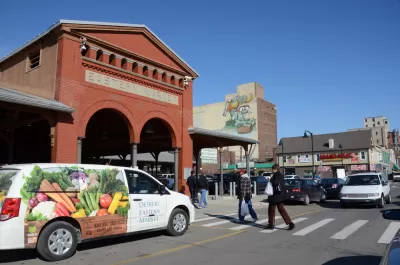Detroit's historic food district is under very contemporary development pressure, so the nonprofit tasked with managing the market has decided to define principles that prioritize affordability and inclusivity in the area.

Eastern Market Corp, the nonprofit that manages the Eastern Market food district in Detroit, is developing a set of protocols to uphold an ambitious set of principles, according to an article by Annalise Frank:
The list of a dozen points that's under development would address the 'core values of the market,' such as carving out 25 percent 'affordable' space for small businesses, and could determine whether or not Eastern Market supports a developer's project, said Dan Carmody, president of the nonprofit.
Frank adds more about the limitations of the system later int he article:
Eastern Market Corp. doesn't have the "ability to tell people how to run their business," he said, but it could use this protocol to score a building project in the market and decide whether or not the nonprofit will give support to the project in the course of city of Detroit approvals.
According to Frank, the Eastern Market, located in an historic neighborhood north of downtown is facing development pressure that local preservationists fear could alter the inclusivity and historic character of the market. "The district's growing pains came to a head this week when longtime fixture Russell Street Deli announced it would close in September due to a dispute with its new landlord, Nelson, over repairs and a proposed rent increase from $1,700 to $3,500 a month," according to Frank.
FULL STORY: Eastern Market makes plans to preserve affordability, 'core values' in changing food district

Planetizen Federal Action Tracker
A weekly monitor of how Trump’s orders and actions are impacting planners and planning in America.

Maui's Vacation Rental Debate Turns Ugly
Verbal attacks, misinformation campaigns and fistfights plague a high-stakes debate to convert thousands of vacation rentals into long-term housing.

Restaurant Patios Were a Pandemic Win — Why Were They so Hard to Keep?
Social distancing requirements and changes in travel patterns prompted cities to pilot new uses for street and sidewalk space. Then it got complicated.

In California Battle of Housing vs. Environment, Housing Just Won
A new state law significantly limits the power of CEQA, an environmental review law that served as a powerful tool for blocking new development.

Boulder Eliminates Parking Minimums Citywide
Officials estimate the cost of building a single underground parking space at up to $100,000.

Orange County, Florida Adopts Largest US “Sprawl Repair” Code
The ‘Orange Code’ seeks to rectify decades of sprawl-inducing, car-oriented development.
Urban Design for Planners 1: Software Tools
This six-course series explores essential urban design concepts using open source software and equips planners with the tools they need to participate fully in the urban design process.
Planning for Universal Design
Learn the tools for implementing Universal Design in planning regulations.
Heyer Gruel & Associates PA
JM Goldson LLC
Custer County Colorado
City of Camden Redevelopment Agency
City of Astoria
Transportation Research & Education Center (TREC) at Portland State University
Jefferson Parish Government
Camden Redevelopment Agency
City of Claremont





























